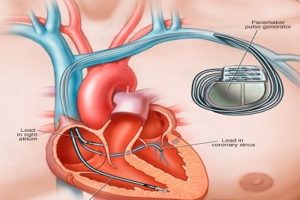Procedures and Risks with Pacemaker Implantation

What is a pacemaker?
A pacemaker is a medical device which generates electrical impulses delivered by electrodes to contract the heart muscles and regulate the electrical conduction system of the heart.
What is a pacemaker implantation?
A pacemaker implantation is a procedure in which the cardiologist places a pacemaker in your chest.
When is it used?
This procedure is most often done when your heart rate is too slow. As a result of the abnormal rate, your heart pumps less blood, causing symptoms such as fatigue, shortness of breath, or fainting.
How do I prepare for pacemaker implantation?
Plan for your care and recovery after the operation, especially if you are to have general anesthesia. Allow for time to rest and try to find people to help you with your day-to-day duties.
Follow any instructions your cardiologist may give you. If you are to have general anesthesia, eat a light meal, such as soup or salad the night before the procedure. Do not eat or drink anything after midnight and the morning before the procedure. Do not even drink coffee, tea, or water.
No special preparation is needed for local anesthesia.
What happens during the procedure?
You will be given a general or local anesthetic. A general anesthetic will relax your muscles and make you feel as if you are in a deep sleep. It will prevent you from feeling pain during the operation. A local anesthetic, usually combined with mild sedatives, also will keep you from feeling pain during the operation. If you feel discomfort during the procedure, tell your cardiologist immediately.
The nurse will wash your upper chest and sometimes shave the area. The cardiologist will make a cut in the skin over the upper chest and separate the tissues to make a place for the pacemaker. The artificial pacemaker system consists of one or two electrodes and a battery unit. The electrodes — wires that are insulated nearly to their tips — are inserted into a vein located under your collarbone. With the help of x-rays, the cardiologist places them in your right atrium and right ventricle. The tips of the electrodes make contact with your heart muscle and transmit the electrical impulse that stimulates the heartbeat. The other ends of the electrodes are connected to the pacemaker unit, which contains batteries and electronic circuits. The cardiologist places this unit beneath the skin of your upper chest.
What happens after the procedure?
You may stay in the hospital for 1 to 3 days, depending on your condition. You will remain in bed and your heart will be monitored. The day after the procedure you will be encouraged to walk in preparation for leaving the hospital.
Before you leave the hospital, your cardiologist will check your pacemaker using a small table-top computer, called a programmer, and a wand. The wand is about the same size as a remote control. Your provider puts the wand on your body, about where the pacemaker is located. This allows your cardiologist to get information from the pacemaker about what the heart is doing and how well it is working. If needed, your cardiologist can adjust the pacemaker using the programmer and the wand. It is not painful, and it usually takes just a few minutes.
You may learn how to check the function of the pacemaker using the telephone. The function of the pacemaker can also be checked at follow-up visits with your cardiologist.
Your cardiologist may explain how having a pacemaker might affect your lifestyle and when the battery in the pacemaker may need to be replaced.
Ask your cardiologist what other steps you should take and when you should come back for a checkup.
What are the benefits of this procedure?
Your heart may beat in a healthy rhythm, and you may resume a more normal lifestyle.
What are the risks associated with this procedure?
- There are some risks when you have local anesthesia. Discuss these risks with your cardiologist.
- A local anesthesia may not numb the area quite enough and you may feel some minor discomfort. Also, in rare cases, you may have an allergic reaction to the drug used in this type of anesthesia. Local anesthesia is considered safer than general anesthesia.
- Very rarely, wire could puncture one of the lungs, the vein, or the heart cavity.
- The pacemaker is implanted because the heart rhythm is abnormal. This may be associated with other heart disease, which could worsen despite correction of the rhythm.
- Like any electrical/mechanical device, the pacemaker may need a replacement if it stops working properly.
- The pacemaker wire may become dislodged and/or break.
- There is a risk of infection and/or bleeding.
You should ask your cardiologist how these risks apply to you.
When should I call the cardiologist?
Call the cardiologist immediately if your pulse becomes abnormally slow, fast, or irregular, or your original symptoms return.
Call the cardiologist during office hours if:
- You have questions about the procedure or its result.
- You want to make an appointment.